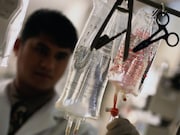Anaphylactic, anaphylactoid reactions linked to PICC insertion using Sherlock tip locating system
THURSDAY, Oct. 10, 2019 (HealthDay News) — Potential anaphylactic or anaphylactoid reactions have been associated with insertion of peripherally inserted central catheters (PICCs) using the Sherlock tip locating system (TLS), which features a magnetized stylet wire, according to a study published online Oct. 8 in Infection Control & Hospital Epidemiology.
Christina S. Thornton, Ph.D., M.D., from the University of Calgary and Alberta Health Services in Canada, and colleagues monitored patients from two tertiary-care hospitals over four years for adverse events following insertion of a PICC using the Sherlock TLS. Insertion data were obtained using the BioFlo PICC from two sites as a comparator.
The researchers identified 37 potential reactions among 8,257 insertions using the TLS PICCs (0.45 percent). Overall, 54.1 to 91.9 percent met the criteria using specific definitions for anaphylaxis or anaphylactoid reactions. No reactions were identified in comparator populations (491 from Calgary and 7,889 from Ottawa) using the BioFlo PICC insertion. Across all definitions, anaphylactic or anaphylactoid reactions were significantly associated with the PowerPICC SOLO and Groshong PICC with the TLS compared with the BioFlo PICC. Overall, 10.8 percent of patients experiencing adverse reactions had cystic fibrosis (CF).
“Given the disproportionate rate of anaphylactic or anaphylactic-like reactions following PICC insertion observed in CF patients (i.e., 10- to 20-fold higher compared to the general population, 10 percent to 16 percent versus 0.5 percent), our observations suggest the need for additional clinical vigilance in the CF population,” the authors write.
Copyright © 2019 HealthDay. All rights reserved.








